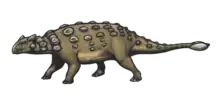| Huayangosaurids | |
|---|---|
 | |
| Holotype skull of Huayangosaurus taibaii | |
| Scientific classification | |
| Domain: | Eukaryota |
| Kingdom: | Animalia |
| Phylum: | Chordata |
| Clade: | Dinosauria |
| Clade: | †Ornithischia |
| Clade: | †Thyreophora |
| Suborder: | †Stegosauria |
| Family: | †Huayangosauridae Dong et al., 1982[1] |
| Genera[2] | |
| Synonyms | |
| |
Huayangosauridae (derived from Huayangosaurus, "Huayang reptile") is a family of stegosaurian dinosaurs from the Jurassic of China.[1] The group is defined as all taxa closer to the namesake genus Huayangosaurus than Stegosaurus, and was originally named as the family Huayangosaurinae by Dong Zhiming and colleagues in the description of Huayangosaurus.[1][2] Huayangosaurinae was originally differentiated by the remaining taxa within Stegosauridae by the presence of teeth in the premaxilla, an antorbital fenestra, and a mandibular fenestra. Huayangosaurinae, known from the Middle Jurassic of the Shaximiao Formation, was proposed to be intermediate between Scelidosaurinae and Stegosaurinae, suggesting that the origins of stegosaurs lay in Asia.[1] Following phylogenetic analyses, Huayangosauridae was expanded to also include the taxon Chungkingosaurus, known from specimens from younger Late Jurassic deposits of the Shaximiao Formation.[3] Huayangosauridae is either the sister taxon to all other stegosaurs,[3][4] or close to the origin of the clade, with taxa like Gigantspinosaurus or Isaberrysaura outside the Stegosauridae-Huayangosauridae split.[2][4] Huayangosauridae was formally defined in 2021 by Daniel Madzia and colleagues, who used the previous definitions of all taxa closer to Huayangosaurus taibaii than Stegosaurus stenops, and chose the 2020 phylogeny of Susannah Maidment et al. to illustrate the relationships of the clade:[2][5]
| Stegosauria |
| |||||||||||||||||||||||||||
References
- 1 2 3 4 Dong, Z.; Tang, Z.; Zhou, S.W. (1982). "四川自贡大山铺蜀龙动物群简报1.剑龙" [Note on the new Mid-Jurassic stegosaur from Sichuan Basin, China] (PDF). Vertebrata PalAsiatica (in Chinese (China)). 20 (1): 83–87.
- 1 2 3 4 Madzia, D.; Arbour, V.M.; Boyd, C.A.; Farke, A.A.; Cruzado-Caballero, P.; Evans, D.C. (2021). "The phylogenetic nomenclature of ornithischian dinosaurs". PeerJ. 9: e12362. doi:10.7717/peerj.12362. PMC 8667728. PMID 34966571.
- 1 2 Maidment, S.C.R.; Norman, D.B.; Barrett, P.M.; Upchurch, P. (2008). "Systematics and phylogeny of Stegosauria (Dinosauria: Ornithischia)". Journal of Systematic Palaeontology. 6 (4): 367–407. doi:10.1017/S1477201908002459. S2CID 85673680.
- 1 2 Maidment, S.C.R. (2010). "Stegosauria: a historical review of the body fossil record and phylogenetic relationships". Swiss Journal of Geosciences. 103 (Supplement 2, Symposium on Stegosauria): 199–210. doi:10.1007/s00015-010-0023-3. S2CID 84415016.
- ↑ Maidment, S.C.R.; Raven, T.J.; Ouarhache, D.; Barrett, P.M. (2020). "North Africa's first stegosaur: Implications for Gondwanan thyreophoran dinosaur diversity". Gondwana Research. 77: 82–97. doi:10.1016/j.gr.2019.07.007. hdl:10141/622706. S2CID 202188261.

